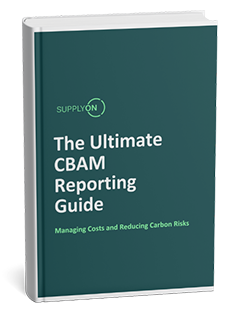3 Key Strategies for Implementing a Successful PCF Exchange

Managing carbon footprint data is essential for modern businesses aiming to meet sustainability goals and regulatory demands. In sectors like automotive, where intricate supply chains are the norm, mastering Product Carbon Footprint (PCF) exchange is not just beneficial—it’s essential for achieving substantial environmental progress and better-informed decision-making.
However, collecting accurate PCF data can be challenging due to complex supplier networks and varying data formats. This post outlines three key strategies to facilitate a successful PCF exchange, ensuring more effective sustainability practices.
Strategy 1: Engage and Collaborate with Suppliers
Effective supplier engagement is the cornerstone of a successful PCF exchange. Creating a collaborative environment ensures smoother data collection and strengthens relationships throughout the supply chain.
Early Communication
Laying the groundwork for PCF data exchange starts with early and transparent communication. Informing suppliers about your PCF data requirements and sustainability targets well ahead of time can help establish a shared understanding and reduce potential roadblocks. Early engagement also allows suppliers to prepare their processes to meet your expectations, leading to smoother data collection.
Practical ways to establish early communication include virtual workshops, documentation on data formats, and detailed guidelines for submission. These measures create clarity and set the stage for more efficient collaboration.
Building Strong Relationships
A successful PCF exchange thrives on strong, trust-based relationships with suppliers. Such relationships encourage open data sharing and create a sense of mutual investment in the process. To build this trust, consider hosting regular check-ins, co-creating sustainability initiatives, and offering feedback on data submissions. When suppliers understand that their efforts contribute to a larger mission, they’re more likely to participate actively.
Supporting Suppliers
While large suppliers might have the infrastructure to handle complex data reporting, smaller suppliers may need more support. Providing resources like training sessions, educational materials, or Q&A forums can empower them to meet PCF requirements effectively. A well-supported supplier network leads to more reliable data collection and greater buy-in across the supply chain.
Strategy 2: Leverage Technology with a Dedicated PCF Exchange Tool
Leveraging the right technology can transform how PCF data is collected, managed, and shared. Implementing a dedicated PCF exchange tool makes it easier to maintain consistency and streamline processes.
The Role of Technology
Technology is indispensable for managing PCF data collection and exchange at scale. A dedicated PCF exchange tool can streamline the process, ensuring that data collection is efficient, consistent, and accurate. Such tools centralize data management and automate aspects of the process, tackling issues like data inconsistency and collaboration barriers.
Digital platforms simplify data requests, track responses, and allow for automated validation processes, freeing up your team to focus on analyzing the data instead of chasing it.
Features to Look For
To make the most of a PCF exchange tool, ensure it includes the following features:
- Comprehensive Data Queries: The ability to request detailed PCF data for multiple components and suppliers, whether for existing materials or new tenders.
- Efficient Monitoring and Communication: Built-in features to track, accept, or reject data submissions and communicate directly with suppliers to resolve issues quickly.
- Seamless Integration with API Interfaces: Integration capabilities that allow data to flow into existing enterprise systems, minimizing manual input and errors.
- Configurable Query Templates: Customizable templates for data requests simplify the collection process and ensure that data formats are standardized.
- Interoperability: A tool that can connect with networks like Catena-X is valuable for staying aligned with industry standards and future regulatory changes.
Benefits
The right technology not only saves time but also improves data accuracy and enables better decision-making. By automating routine tasks and centralizing data collection, companies can use PCF data effectively to inform sustainability strategies and drive decarbonization efforts.
Strategy 3: Ensure Data Quality and Drive Continuous Improvement
Ensuring data quality is key to a successful PCF exchange, as it supports reliable sustainability reporting and better decision-making. Continuous improvement efforts further reinforce these outcomes.
Implement Verification Processes
Having a verification process in place is essential to maintain data integrity. Automated checks combined with manual reviews ensure that the data you receive is both accurate and reliable. Implementing these processes helps catch inconsistencies early and supports compliance with sustainability standards.
Monitor Progress
Regularly tracking PCF data against your sustainability goals is key to maintaining momentum. Analytics tools can help identify trends, highlight problem areas, and offer insights for optimizing supply chain practices. Regular monitoring also provides a way to measure the effectiveness of your sustainability strategy over time, ensuring that you remain adaptable.
Foster a Culture of Sustainability
Success in PCF exchange goes beyond technology and data; it’s about embedding a culture of sustainability within your organization. Regular workshops, sustainability training, and the active involvement of employees and suppliers keep everyone informed and motivated. Recognizing suppliers who meet or exceed data expectations can further incentivize participation and align your supply chain with your environmental goals.
Adapt and Evolve
Staying up-to-date with changes in regulations and industry standards is critical for maintaining a compliant and future-proof strategy. Regularly revisiting and refining your approach helps ensure your PCF exchange process continues to meet both current and emerging demands.
Conclusion
Implementing a successful PCF exchange requires strategic supplier engagement, the use of reliable technology, and a focus on data quality. By following these strategies, your organization can overcome challenges in PCF data collection and leverage accurate insights to drive meaningful decarbonization efforts.



